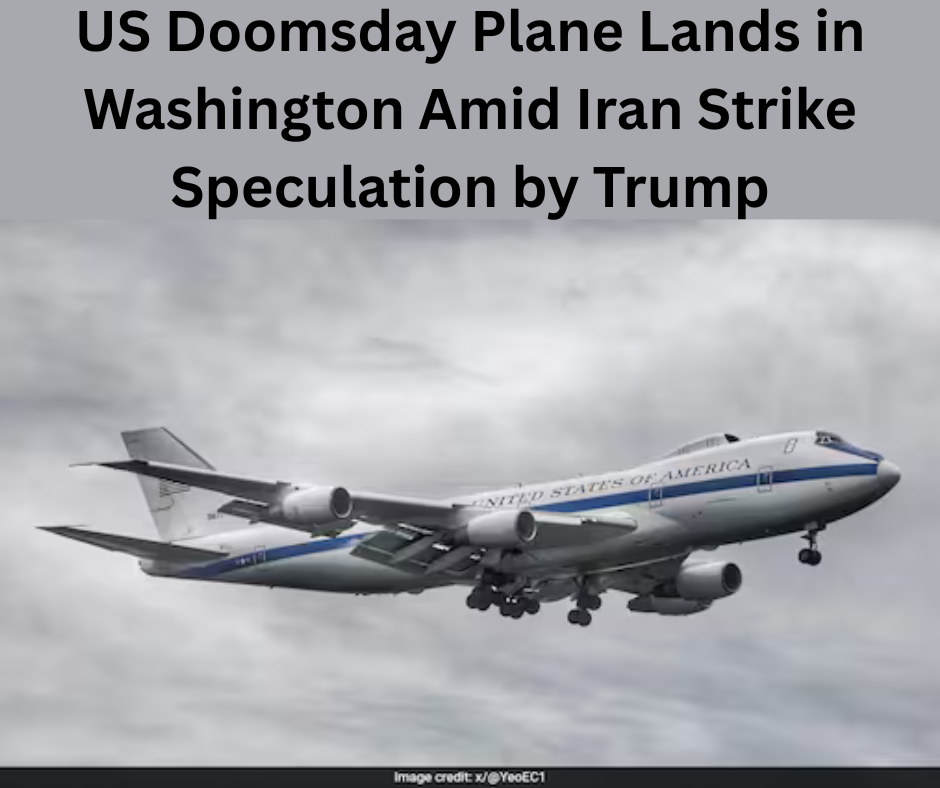US Doomsday Plane Lands in Washington Amid Iran Tensions: What It Means
The US Doomsday Plane—a highly classified and powerful airborne command center capable of surviving nuclear attacks and coordinating retaliation—was recently spotted landing at Joint Base Andrews in Washington, D.C., amid rising tensions between the United States, Iran, and Israel. The aircraft’s unusual and winding flight path from Barksdale Air Force Base in Louisiana sparked widespread speculation about its deployment and timing.
This appearance comes as former President Donald Trump weighs a potential strike on Iran’s nuclear facilities, further amplifying interest in the rare movements of the US Doomsday Plane.
What Is the US Doomsday Plane?
The US Doomsday Plane, officially designated the E-4B Nightwatch, is part of a fleet of four aircraft operated by the US Air Force. These jets serve as the National Airborne Operations Center (NAOC), designed to act as a flying command post in the event of a nuclear war, cyberattack, or any catastrophic national emergency.
Nicknamed the “Flying Pentagon,” each US Doomsday Plane is equipped with:
- Shielding against nuclear blasts and electromagnetic pulses (EMPs)
- The ability to launch and coordinate retaliatory strikes
- Mid-air refueling capabilities
- A 7,000-mile range
- A crew capacity of up to 112 personnel
The aircraft can remain airborne for up to one week, ensuring uninterrupted command, control, and communication in case ground infrastructure is compromised.
Advanced Features of the US Doomsday Plane
The US Doomsday Plane is not just built for resilience; it is also engineered for continuous global communication. Inside its massive airframe, the E-4B houses:
- 67 satellite dishes and antennas
- A briefing room, command center, rest areas, and conference facilities across three decks
- Thermal and nuclear shielding for maximum survivability
- High-bandwidth secure communication systems
This advanced airborne hub enables the President, Secretary of Defense, and Joint Chiefs of Staff to manage military operations in real time—even in the face of nuclear or cyber warfare.
Flight Sparks Speculation During Middle East Crisis
The sudden appearance of the US Doomsday Plane in Washington D.C. occurred as geopolitical tensions intensified between Iran and Israel, raising global concerns. President Trump’s recent remarks, demanding Iran’s “unconditional surrender,” further fueled fears of military escalation.
As Israeli airstrikes reportedly hit Iranian nuclear sites, and Tehran retaliated with missile attacks on Israeli infrastructure, the Middle East teetered on the edge of wider conflict. In this environment, the deployment of the US Doomsday Plane is seen by analysts as a potential signal of elevated military readiness or a precautionary measure.
Historical Use of the US Doomsday Plane
The US Doomsday Plane is rarely deployed for public operations. One of the few instances when it was prominently used was during the September 11, 2001, terrorist attacks, when it became a central hub for coordinating US defense responses. Its presence is often reserved for high-alert situations, national security threats, or live military readiness exercises.
While the aircraft is occasionally used for training or drills, its latest journey—featuring a highly irregular flight path around the coasts of Virginia and North Carolina—suggests more than just a routine maneuver.
US Doomsday Plane Deployment: Strategic or Symbolic?
Military experts and aviation analysts point to the plane’s movement as a calculated show of strength and preparedness. Though the US Air Force has not issued an official statement regarding this specific mission, the timing aligns too closely with the Iran-Israel conflict and US deliberations to be dismissed as coincidental.
The US Doomsday Plane reinforces a core message: the US military is ready for any eventuality. Its activation may serve multiple purposes:
- Deter potential adversaries
- Reassure allies of US command capabilities
- Prepare for potential command transitions or emergency communications
Iran Rejects US Demands Amid Continued Strikes
In response to President Trump’s ultimatum, Iran’s Supreme Leader Ayatollah Ali Khamenei defiantly rejected the US demands, stating, “The Iranian nation isn’t frightened by such threats.” With missile attacks on Iranian infrastructure intensifying and airspace security compromised, many believe high-ranking Iranian officials are relocating or seeking diplomatic off-ramps in nearby neutral countries like Oman.
The US Doomsday Plane’s presence near Washington during this critical juncture may also reflect the need for heightened presidential security and rapid military coordination, especially if conflict escalates quickly.
The Future of the US Doomsday Plane Program
While the E-4B remains a central part of the US national defense apparatus, the Air Force has begun planning its replacement. In April 2024, the Pentagon signed a $13 billion contract with Sierra Nevada Corporation to develop a next-generation airborne command center.
This new aircraft is expected to offer even more advanced communication, shielding, and autonomous operations—but until its arrival, the US Doomsday Plane remains the most robust airborne defense platform in the American arsenal.
Conclusion: US Doomsday Plane Signals Strength Amid Global Uncertainty
The sighting of the US Doomsday Plane over Washington is more than just a logistical event—it’s a message. As military tensions rise and diplomatic options thin, the E-4B’s presence reflects the US commitment to readiness, resilience, and rapid response.
While the future remains uncertain in the Middle East, one thing is clear: the US Doomsday Plane is a symbol of unwavering national defense and technological superiority in the face of global threats.
Read more: Travelers Championship 2025
